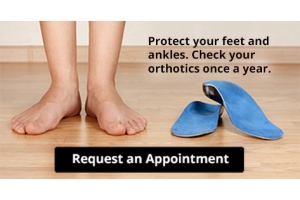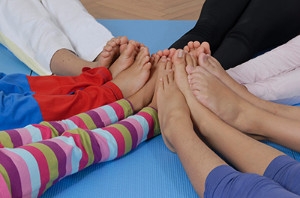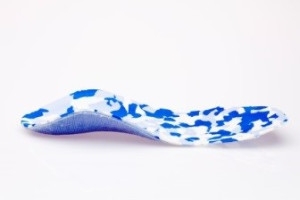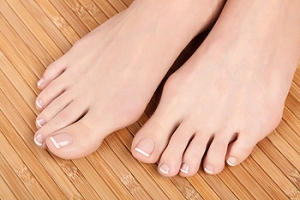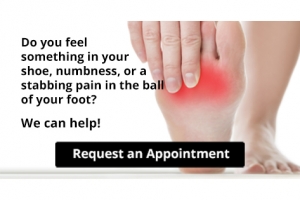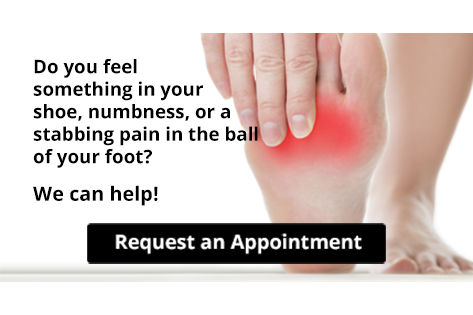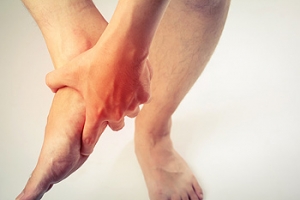
Reminder: When Was the Last Time...?
Facts About My Child’s Feet
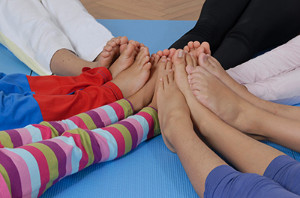 It typically takes 18 years for strong bones to fully develop in a child’s foot. Research has suggested that by observing your child’s posture and gait, common foot ailments may be avoided. A child typically begins to walk around 12 months of age, and going barefoot a majority of the time is beneficial to developing strong muscles. As a child’s foot develops, the shape of the foot may change, causing different size shoes to be worn every 6 months until the feet stop growing. There are several things you can do to optimize your child’s foot health, including choosing shoes with ample room for the toes to straighten and avoiding socks that are constrictive. When assessing your child’s shoe size, it’s important that both feet are measured correctly. The shoes should also feel comfortable while trying them on and should not have to be broken in. If your child complains of heel pain, especially if sports are an integral part of their daily activities, please consider a consultation with a podiatrist for an accurate diagnosis.
It typically takes 18 years for strong bones to fully develop in a child’s foot. Research has suggested that by observing your child’s posture and gait, common foot ailments may be avoided. A child typically begins to walk around 12 months of age, and going barefoot a majority of the time is beneficial to developing strong muscles. As a child’s foot develops, the shape of the foot may change, causing different size shoes to be worn every 6 months until the feet stop growing. There are several things you can do to optimize your child’s foot health, including choosing shoes with ample room for the toes to straighten and avoiding socks that are constrictive. When assessing your child’s shoe size, it’s important that both feet are measured correctly. The shoes should also feel comfortable while trying them on and should not have to be broken in. If your child complains of heel pain, especially if sports are an integral part of their daily activities, please consider a consultation with a podiatrist for an accurate diagnosis.
Making sure that your children maintain good foot health is very important as they grow. If you have any questions, contact one of our podiatrists of James Kutchback, DPM, CWS-P. Our doctors can provide the care you need to keep you pain-free and on your feet.
Keeping Children's Feet Healthy
Having healthy feet during childhood can help prevent medical problems later in life, namely in the back and legs. As children grow, their feet require different types of care. Here are some things to consider...
Although babies do not walk yet, it is still very important to take care of their feet.
Avoid putting tight shoes or socks on his or her feet.
Allow the baby to stretch and kick his or her feet to feel comfortable.
As a toddler, kids are now on the move and begin to develop differently. At this age, toddlers are getting a feel for walking, so don’t be alarmed if your toddler is unsteady or ‘walks funny’.
As your child gets older, it is important to teach them how to take care of their feet.
Show them proper hygiene to prevent infections such as fungus.
Be watchful for any pain or injury.
Have all injuries checked by a doctor as soon as possible.
Comfortable, protective shoes should always be worn, especially at play.
If you have any questions, please feel free to contact our offices located in The Woodlands and Woodville, TX . We offer the newest diagnostic and treatment technologies for all your foot care needs.
What to Do to Keep Your Child’s Feet Healthy
Being a parent involves caring for your child in every way you can. You make sure they are eating the right food, being nice to others, and staying out of any trouble. However, it is also important that you are watchful of their health, more specifically their foot health. Maintaining good foot health in childhood is important in preventing later conditions in life from happening. As children continue to develop, their feet require different techniques of care. Here are some various ways in which you can help your child’s feet stay healthy.
A baby needs a lot of care and attention overall, but the importance of their feet should never be forgotten. Before a baby turns one, their feet change and develop greatly. It is important that during this time, a mother avoids putting tight socks on their child. She should also encourage movement of their feet so the baby can begin to feel more comfortable using them.
As a baby enters the toddler years of his or her life, they are begin to walk around. When your baby begins to take those first steps, it is crucial that they are wearing protective shoes on their feet. As a mother that is observant of your child’s feet, you may notice changes in them. This is completely normal as the feet are becoming susceptible to the activity of walking. It is normal for a toddler to be a bit unsteady or to “walk funny” at first.
When your child grows out of their toddler years, it is important that you begin to show him or her how to care for their feet on their own. Practice with your child proper hygiene in order to prevent foot fungus or infection. Since children are constantly on the move, it is crucial to be cautious of any accidents or injuries that might occur. If an injury occurs, it is advised that you take your child to be examined by a doctor immediately. Since your child is still growing, particular injuries can shift the way in which a bone or other important part of the foot is developing.
Babies and kids are always changing and growing. Your job as a parent is to make sure they stay healthy and making sure they are properly maintained. This involves proper foot care and making sure the feet stay healthy. Following this guide, your child can live a long and happy life.
Can Orthotics Help More Than My Feet?
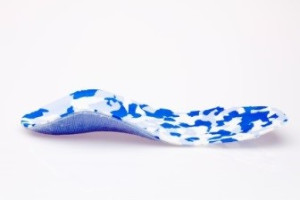 If you are experiencing abnormal walking patterns, you may want to consider wearing orthotics. Orthotics are custom-made inserts that are slipped into your shoes. Generally, an impression of your feet is taken to obtain a perfect fit, preventing any feelings of discomfort. The benefits of wearing orthotics may include keeping the foot stable while performing daily activities and helping to correct debilitating pronation. They’re also beneficial in aiding in conditions such as bunions, corns, and heel pain. It may take some time to get used to your new orthotics, since your feet have been functioning in a certain way for years. Therefore, a gradual increase in wearing them may be recommended. Please consider a consultation with a podiatrist for advice on how you can be measured for custom-made orthotics.
If you are experiencing abnormal walking patterns, you may want to consider wearing orthotics. Orthotics are custom-made inserts that are slipped into your shoes. Generally, an impression of your feet is taken to obtain a perfect fit, preventing any feelings of discomfort. The benefits of wearing orthotics may include keeping the foot stable while performing daily activities and helping to correct debilitating pronation. They’re also beneficial in aiding in conditions such as bunions, corns, and heel pain. It may take some time to get used to your new orthotics, since your feet have been functioning in a certain way for years. Therefore, a gradual increase in wearing them may be recommended. Please consider a consultation with a podiatrist for advice on how you can be measured for custom-made orthotics.
If you are having discomfort in your feet and would like to try orthotics, contact one of our podiatrists from James Kutchback, DPM, CWS-P. Our doctors can provide the care you need to keep you pain-free and on your feet.
What Are Orthotics?
Orthotics are inserts you can place into your shoes to help with a variety of foot problems such as flat feet or foot pain. Orthotics provide relief and comfort for minor foot and heel pain but can’t correct serious biomechanical problems in your feet.
Over-the-Counter Inserts
Orthotics come in a wide variety of over-the-counter inserts that are used to treat foot pain, heel pain, and minor problems. For example, arch supports can be inserted into your shoes to help correct overarched or flat feet, while gel insoles are often used because they provide comfort and relief from foot and heel pain by alleviating pressure.
Prescription Orthotics
If over-the-counter inserts don’t work for you or if you have a more severe foot concern, it is possible to have your podiatrist prescribe custom orthotics. These high-quality inserts are designed to treat problems such as abnormal motion, plantar fasciitis, and severe forms of heel pain. They can even be used to help patients suffering from diabetes by treating foot ulcers and painful calluses and are usually molded to your feet individually, which allows them to provide full support and comfort.
If you are experiencing minor to severe foot or heel pain, it’s recommended to speak with your podiatrist about the possibilities of using orthotics. A podiatrist can determine which type of orthotic is right for you and allow you to take the first steps towards being pain-free.
If you have any questions, please feel free to contact our offices located in The Woodlands and Woodville, TX . We offer the newest diagnostic and treatment technologies for all your foot care needs.
Foot Orthotics
Orthotics are shoe inserts that are meant to correct an irregular walking gait or provide cushioning to the feet. Orthotics come in a variety of different models and sizes, including over-the-counter and customizable variants. Customizable orthotics can be shaped and contoured to fit inside a specific shoe and are typically prescribed through a podiatrist who specializes in customized footwear and orthotics design and management.
Orthotics are beneficial because they can help prevent injuries from occurring and provide cushioning to keep pain levels down to a minimum. They also allow for the correct positioning of the feet. Orthotics can act as shock absorbers to help remove pressure from the foot and ankle. Therefore, orthotics can make bodily movements, such as walking and running, become more comfortable as well as help prevent the development of certain foot conditions.
Orthotics alleviate pain and make the foot more comfortable by slightly altering the angle at which the foot strikes the ground surface, therefore controlling the movement of the foot and ankle. Orthotics come in different variants and can be made of various materials. To determine what type of orthotic is most suited to your feet and your needs, it is best to consult your podiatrist. He or she will be able to recommend a type of orthotic that can help improve your foot function or prescribe a custom orthotic to best fit your feet.
Why Do My Feet Sweat?
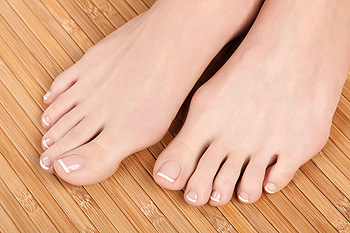 If you notice damp footprints while walking barefoot or sweat that’s ruining your shoes, you may have a condition called plantar hyperhidrosis. In layman's terms, it’s excessive sweating of the feet. Sweating is a normal and necessary bodily function, eliminating excess water and salt. Additionally, it helps to keep the skin moist by cooling the body, which aids in heat regulation. Possible causes of this condition may be anxiety or emotional stress, excessive standing most of the day, or improper footwear which may not absorb the sweat that’s produced. Obesity may also be a contributing factor for this condition and is generally associated with increased sweating, though not always. Some helpful measures include washing and drying the feet daily, especially between the toes, in addition to using a antifungal foot powder to ward off potential fungal infections. If you feel your feet are sweating excessively, please consult a podiatrist for a proper diagnosis and available treatment options.
If you notice damp footprints while walking barefoot or sweat that’s ruining your shoes, you may have a condition called plantar hyperhidrosis. In layman's terms, it’s excessive sweating of the feet. Sweating is a normal and necessary bodily function, eliminating excess water and salt. Additionally, it helps to keep the skin moist by cooling the body, which aids in heat regulation. Possible causes of this condition may be anxiety or emotional stress, excessive standing most of the day, or improper footwear which may not absorb the sweat that’s produced. Obesity may also be a contributing factor for this condition and is generally associated with increased sweating, though not always. Some helpful measures include washing and drying the feet daily, especially between the toes, in addition to using a antifungal foot powder to ward off potential fungal infections. If you feel your feet are sweating excessively, please consult a podiatrist for a proper diagnosis and available treatment options.
If you are suffering from hyperhidrosis contact one of our podiatrists of James Kutchback, DPM, CWS-P. Our doctors can provide the care you need to attend to all of your foot and ankle needs.
Hyperhidrosis of the Feet
Hyperhidrosis is a rare disorder that can cause people to have excessive sweating of their feet. This can usually occur all on its own without rigorous activity involved. People who suffer from hyperhidrosis may also experience sweaty palms.
Although it is said that sweating is a healthy process meant to cool down the body temperature and to maintain a proper internal temperature, hyperhidrosis may prove to be a huge hindrance on a person’s everyday life.
Plantar hyperhidrosis is considered to be the main form of hyperhidrosis. Secondary hyperhidrosis can refer to sweating that occurs in areas other than the feet or hands and armpits. Often this may be a sign of it being related to another medical condition such as menopause, hyperthyroidism and even Parkinson’s disease.
In order to alleviate this condition, it is important to see your doctor so that they may prescribe the necessary medications so that you can begin to live a normal life again. If this is left untreated, it is said that it will persist throughout an individual’s life.
A last resort approach would be surgery, but it is best to speak with your doctor to find out what may be the best treatment for you.
If you have any questions, please feel free to contact our offices located in The Woodlands and Woodville, TX . We offer the newest diagnostic and treatment technologies for all your foot care needs.
Hyperhidrosis of the Feet
Hyperhidrosis of the feet, also termed plantar hyperhidrosis, is characterized by excessive sweating of the feet that can be onset by any cause, such as exercise, fever, or anxiety. Most people suffering from hyperhidrosis of the feet also experience hyperhidrosis of the hands, or palmar hyperhidrosis. Approximately 1-2% of Americans suffer from this disorder.
Sweating is a healthy process utilized by the body in order to cool itself and maintain a proper internal temperature, which is controlled by the sympathetic nervous system. In individuals with hyperhidrosis, the sympathetic nervous system works in "overdrive", producing far more sweat than is actually needed.
Plantar hyperhidrosis is considered primary hyperhidrosis. Secondary hyperhidrosis refers to excessive sweating that occurs in an area other than the feet, hands, or armpits, and this indicates that is related to another medical condition, such as menopause, hyperthyroidism, or Parkinson's disease.
Symptoms of hyperhidrosis of the feet can include foot odor, athlete's foot, infections, and blisters. Because of the continual moisture, shoes and socks can rot which creates an additional foul odor and can ruin the material, requiring shoes and socks to be replaced frequently. In addition to the physical symptoms, emotional health is often affected as this disorder can be very embarrassing.
If left untreated, hyperhidrosis will usually persist throughout an individual's life. However, there are several treatment options available. A common first approach to treating hyperhidrosis of the feet is a topical ointment. Aluminum chloride, an ingredient found in antiperspirants, can be effective at treating hyperhidrosis if used in high concentration and applied to the foot daily. Some individuals can experience relief this way, while others encounter extreme irritation and are unable to use the product. Another procedure is the use of Botulinum Toxin A, commonly referred to as Botox. This is injected directly into the foot, and is effective at minimizing the sweat glands in the injected area. These injections must be repeated every 4 to 9 months.
If these treatments are ineffective, oral prescription medications may be taken in an effort to alleviate the symptoms. Again, some will experience relief while others do not. Going barefoot reportedly provides relief for most sufferers.
A final approach to combating hyperhidrosis of the feet is through surgery. Surgery has been less successful on patients with plantar hyperhidrosis than on those with palmar hyperhidrosis. It is only recommended when sweating is severe and other treatments have failed to work. This kind of surgery usually involves going into the central nervous system, and cutting nerves to stop the transmission of signals telling the foot to sweat.
Why Live with Pain and Numbness in Your Feet?
How Can I Treat My Heel Pain?
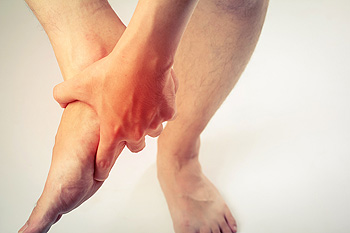 Heel pain tends to be worse in the morning or after a long period of standing. Gradually worsening over time, the pain may become increasingly severe while walking because of the weight placed on the heel. A common cause of this condition may be a pre-existing injury affecting the plantar fascia, or the tissue that runs under the bottom of the foot. The plantar fascia is a connective tendon that acts like a shock absorber, and if damage occurs, it may become inflamed and torn. A common group of people that experience heel pain are joggers and older adults; usually 1 in 10 of the population will endure heel pain during their lives. Treatments can include stretching regularly and wearing shoes with proper support and cushioning. There are other methods that may prevent heel pain, including eating a healthy diet, partaking in regular exercise, and wearing shoes without heels. A consultation with a podiatrist may be advised for proper diagnosis and treatment if your heel pain continues.
Heel pain tends to be worse in the morning or after a long period of standing. Gradually worsening over time, the pain may become increasingly severe while walking because of the weight placed on the heel. A common cause of this condition may be a pre-existing injury affecting the plantar fascia, or the tissue that runs under the bottom of the foot. The plantar fascia is a connective tendon that acts like a shock absorber, and if damage occurs, it may become inflamed and torn. A common group of people that experience heel pain are joggers and older adults; usually 1 in 10 of the population will endure heel pain during their lives. Treatments can include stretching regularly and wearing shoes with proper support and cushioning. There are other methods that may prevent heel pain, including eating a healthy diet, partaking in regular exercise, and wearing shoes without heels. A consultation with a podiatrist may be advised for proper diagnosis and treatment if your heel pain continues.
Many people suffer from bouts of heel pain. For more information, contact one of our podiatrists of James Kutchback, DPM, CWS-P. Our doctors can provide the care you need to keep you pain-free and on your feet.
Causes of Heel Pain
Heel pain is often associated with plantar fasciitis. The plantar fascia is a band of tissues that extends along the bottom of the foot. A rip or tear in this ligament can cause inflammation of the tissue.
Achilles tendonitis is another cause of heel pain. Inflammation of the Achilles tendon will cause pain from fractures and muscle tearing. Lack of flexibility is also another symptom.
Heel spurs are another cause of pain. When the tissues of the plantar fascia undergo a great deal of stress, it can lead to ligament separation from the heel bone, causing heel spurs.
Why Might Heel Pain Occur?
- Wearing ill-fitting shoes
- Wearing non-supportive shoes
- Weight change
- Excessive running
Treatments
Heel pain should be treated as soon as possible for immediate results. Keeping your feet in a stress-free environment will help. If you suffer from Achilles tendonitis or plantar fasciitis, applying ice will reduce the swelling. Stretching before an exercise like running will help the muscles. Using all these tips will help make heel pain a condition of the past.
If you have any questions, please feel free to contact our offices located in The Woodlands and Woodville, TX . We offer the newest diagnostic and treatment technologies for all your foot care needs.
Heel Pain
Have you ever gotten up from a chair or out of bed in the morning, and upon taking that first step, feel like your heel has stepped on a tack? Many people experience a feeling of sharp pain which radiates into their arch from their heel and which does not allow them to put their heel on the floor. Sometimes they need to sit back down, stand only on their toes and use the wall for balance. If you can take a few steps, it seems to go away and lessen, allowing you to then resume your activity. Later, throughout your day and after a period of rest, it can happen again. If this sounds familiar you may be suffering from your first attack of heel pain.
Heel pain is a debilitating condition that affects day to day activities. Running and walking both causes stress on the heel because the heel is the part of the foot that hits the ground first. This means that the heel is taking on your entire weight. Diagnosis and treatments for heel pain can be easily found through your podiatrist.
Plantar Fasciitis
One of the main causes of heel pain is a condition known as plantar fasciitis. The plantar fascia is a band of tissue that extends along the bottom of the foot, from the toe to the bottom of the heel. A rip or tear in this ligament can cause inflammation of these tissues, resulting in heel pain. People who do not wear proper fitting shoes are often at risk of developing problems such as plantar fasciitis. Unnecessary stress from ill-fitting shoes, weight change, excessive running, and wearing non-supportive shoes on hard surfaces are all causes of plantar fasciitis.
Achilles Tendonitis
Achilles tendonitis is another cause of heel pain. Similar to plantar fasciitis, inflammation of the Achilles tendon will cause heel pain due to stress fractures and muscle tearing. A lack of flexibility of the ankle and heel is an indicator of Achilles tendonitis. If left untreated, this condition can lead to plantar fasciitis and cause even more pain on your heel.
Heel Spur
A third cause of heel pain is a heel spur. A heel spur occurs when the tissues of the plantar fascia undergo a great deal of stress, leading to a separation of the ligament from the heel bone entirely. This results in a pointed fragment of bone on the ball of the foot, known as a heel spur.




